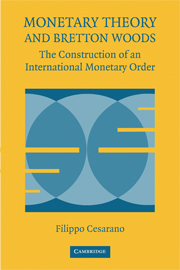Book contents
- Frontmatter
- Contents
- Preface
- Acknowledgments
- 1 INTRODUCTION
- 2 INTERNATIONAL MONETARY EQUILIBRIUM AND THE PROPERTIES OF THE GOLD STANDARD
- 3 THE INTERNATIONAL MONETARY SYSTEM BETWEEN THE WORLD WARS
- 4 THE MONETARY SYSTEM IN ECONOMIC ANALYSIS: THE CRITIQUE OF THE GOLD STANDARD
- 5 THE GREAT DEPRESSION: OVERTURNING THE STATE OF THE ART
- 6 PROVIDING FOR A NEW MONETARY ORDER
- 7 THE BRETTON WOODS AGREEMENTS
- 8 BRETTON WOODS AND AFTER
- References
- Author Index
- Subject Index
4 - THE MONETARY SYSTEM IN ECONOMIC ANALYSIS: THE CRITIQUE OF THE GOLD STANDARD
Published online by Cambridge University Press: 18 December 2009
- Frontmatter
- Contents
- Preface
- Acknowledgments
- 1 INTRODUCTION
- 2 INTERNATIONAL MONETARY EQUILIBRIUM AND THE PROPERTIES OF THE GOLD STANDARD
- 3 THE INTERNATIONAL MONETARY SYSTEM BETWEEN THE WORLD WARS
- 4 THE MONETARY SYSTEM IN ECONOMIC ANALYSIS: THE CRITIQUE OF THE GOLD STANDARD
- 5 THE GREAT DEPRESSION: OVERTURNING THE STATE OF THE ART
- 6 PROVIDING FOR A NEW MONETARY ORDER
- 7 THE BRETTON WOODS AGREEMENTS
- 8 BRETTON WOODS AND AFTER
- References
- Author Index
- Subject Index
Summary
To the monetary historian, the 1920s is the decade of the return to gold. Mindful of the long period of relative stability enjoyed before the war, policymakers wanted above all to restore the gold standard, because orderly monetary conditions were considered to be the prerequisite for renewed growth. Yet, the great difficulties in the way of quickly reinstating the old rules posed new questions and cast serious doubt on the smooth working of commodity money. The economists' advocacy of monetary reform thus gained momentum, with a critical reflection on the optimal design of the institutional framework that had only limited impact on central bankers but nevertheless set in motion the transition toward fiat money. Innovation, however, was necessarily founded on an alternative theoretical model, able to challenge the received view underpinning the gold standard. The spread of a new paradigm sparked a lively debate and clashed with policymakers' reluctance to forsake a monetary order that had proved to be so successful. Hence, proposals of monetary reform seldom considered severing the link with gold altogether. The watershed in the debate was the disruptive shock of the depression, which shattered the intellectual status quo. Before it, the gold standard had continued to predominate and the economists' innovative suggestions had exerted little influence. Afterward, the critique of commodity-based monetary standards gathered momentum and the need to construct a novel system began to emerge.
- Type
- Chapter
- Information
- Monetary Theory and Bretton WoodsThe Construction of an International Monetary Order, pp. 68 - 99Publisher: Cambridge University PressPrint publication year: 2006



